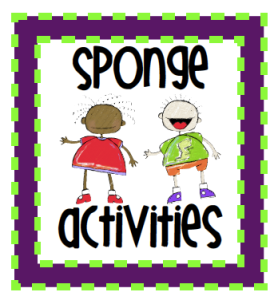November
30
Sponge Activities
Some of the most awkward moments in the classroom are caused by a lesson ending 10 minutes before it is supposed to. There are no worksheets to work on, no more topics to cover, and no more to review. These ten minutes can quickly turn into a 10-minute battle of trying to keep students in their seats and keeping their voices at a low level.

That’s where sponge activities come in! Theses activities are used to fill the last 5-10 minutes of class time with activities that will not only occupy the students, but will also challenge them to think critically. The following is a list of sponge activities suggested by Scholastic.com:
- Play a guessing game that challenges individual students or teams of students to identify as many historical figures as they can in a set period of time. You can also play the game by asking students to identify countries, cities, bodies of water, plants, animals, vegetables, authors, fairy tale characters, weather conditions, cars, television shows, or movies. This game is easy to adapt to a particular content area, unit of study, or student interest.
- Invite student groups to add the numbers in their phone numbers, ages of family members, or street addresses. The group with the highest score wins.
- Go around the room and ask students to name foods, cities, countries, boys’ names, or girls’ names in A-B-C order. (For example: Asparagus, Beef, and Crepes; Albuquerque, Boston, Columbus; Argentina, Botswana, and Cambodia; Aisha, Brittany, and Camilla.)
- Use the newspaper or a supermarket circular to create your own version of The Price Is Right. Ask questions such as “What costs more this week, a head of lettuce or three cucumbers?” “Do you think a mattress costs more or less than a cell phone?”
- Challenge students to identify where various geographic locations (continents, countries, cities, landmarks, bodies of water, etc.) are on a large map. Provide clues as needed.
- Have students figure out the distance between two cities on a map using the scale. Start with short distances and increase the distance as students get more proficient at doing the math and identifying locations.
- Call out states and have students name the capital. Call out capitals and have students match them with the state.
- Call out sports teams (baseball, football, hockey, etc.) and have students identify the city and state they play in.
- Have students identify careers in which people wear uniforms. Have students identify as many careers as they can in a set amount of time.
- Provide students with the monthly average rainfall and/or temperature in your city or state (or have them investigate). Then have them use these figures to determine the average total rainfall for the year and average temperature during each season of the year.
- Challenge students to write acrostic poems for the main character in a story they are reading, a topic they are studying, a favorite subject, or special interest.
- Play short versions of word games like Scattergories, Boggle, Taboo, and Password.
- Write three related words on the board or overhead and have students figure out what they have in common. For example:
- Bears, bats, stalactites (things you might find in a cave);
- Brake, bell, chain (parts of a bike);
- Fiction, mystery, biography (types of books/genres)
- Los Angeles, San Francisco, Sacramento (cities in California); and
- Niagara Falls, Grand Canyon, Redwood Forest (natural wonders).
- Ask students to write down as many food items, animals, flowers/plants, boys’ names, girls’ names, colors, sports figures, historical figures, etc., that begin with a certain letter of the alphabet in two minutes. Use a timer. When time is up, work with the class to write a final list on the board. For example: broccoli, Brussels sprouts, beans, baloney, bagels, Boston cream pie, beef, barley, bell peppers, bok choy, or bread.
- Tell students to list all the words they can using the letters in their last name, first name, a vocabulary word, month of the year, or day of the week.
- Invite students to develop five quiz questions (with an answer sheet) and then exchange papers with their seatmates for an impromptu review.
- Let students become critics and write or deliver quick reviews of recent movies, TV shows, video games, sports events, or restaurant/cafeteria meals.
- Give individuals, pairs, or teams of students a chance to discuss the question “If you had $1,000 to donate to a worthy cause, what would it be and why?”
- List five historical events on the board and ask students to put them in chronological order. Then ask them to list five important events in their personal history and put them in chronological order or on a time line.
- Write a haiku about a favorite relative, holiday, hobby, emotion, or place.
What types of sponge activities do you find effective? Are there any others that you suggest trying?